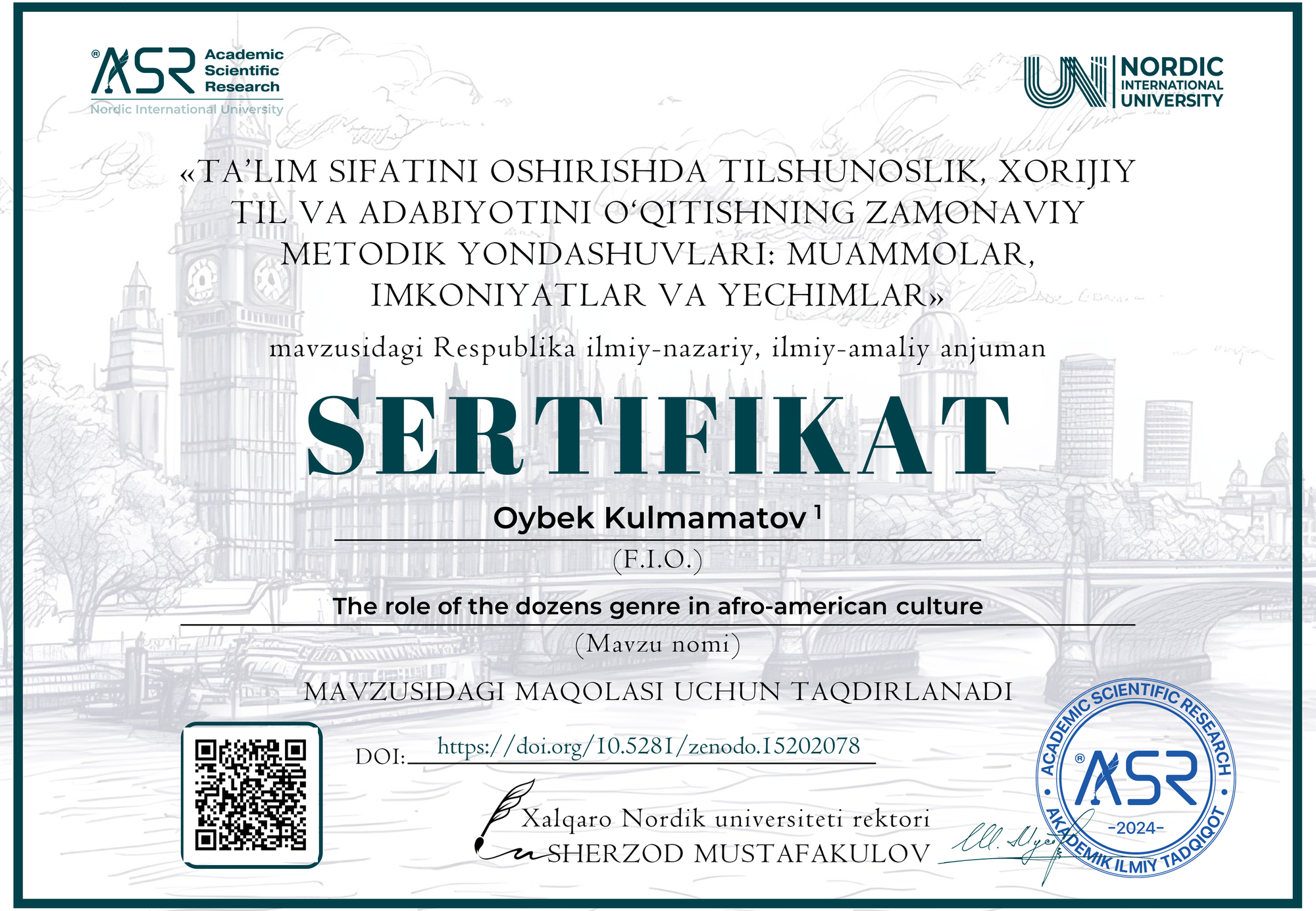Oybek Kulmamatov 1

DOI: https://doi.org/10.5281/zenodo.15202078
Google scholar: https://scholar.google.com/scholar?hl=ru&as_sdt=0%2C5&q=%22THE+ROLE+OF+THE+DOZENS+GENRE+IN+AFRO-AMERICAN+CULTURE%22&btnG=
Zenodo community: https://zenodo.org/records/15202078
Nordic_press journal: https://research.nordicuniversity.org/index.php/nordic/article/view/2349
MAQOLANI YUKLAB OLISH
SERTIFIKATNI YUKLAB OLISH
REVIEW:
In this insightful article, Oybek Kulmamatov explores the historical roots, social functions, and cultural significance of the Dozens, a traditional form of verbal sparring that has long been a staple of Afro-American culture. Kulmamatov traces the origins of the Dozens, highlighting its African roots, its evolution during the period of slavery, and its ongoing impact on modern Black culture, especially in the realms of hip-hop, comedy, and entertainment. The piece effectively underscores how the Dozens not only serves as a form of entertainment but also plays a vital role in social bonding, psychological resilience, and artistic expression within the African American community.
The article begins with a comprehensive overview of the Dozens, defining it as a verbal contest involving witty insults exchanged between two participants, usually in front of an audience. These exchanges, while seemingly playful, carry deep cultural meanings and serve multiple functions. They are not just a battle of insults but an art form that demands verbal dexterity, creativity, and quick thinking. Kulmamatov effectively contextualizes the Dozens within African oral traditions, particularly from West Africa, where verbal skill was highly valued, and competitions of this nature were common. This historical backdrop helps the reader understand the significance of the Dozens as both an entertainment form and a method of cultural expression.
The article also provides an insightful analysis of how the Dozens evolved during the period of slavery in America. Kulmamatov argues that the Dozens became a form of resistance against the dehumanization faced by enslaved Africans, a way to assert dignity and self-worth in a world that sought to strip it away. The author makes an intriguing suggestion that the term "the Dozens" could refer to the practice of selling enslaved people in groups of twelve, further linking the tradition to the painful history of slavery.
Another key aspect discussed is the structure of the Dozens and its rules. The back-and-forth exchanges are characterized by insults that are witty and creative, not meant to cause real harm but rather to entertain and test verbal skill. Kulmamatov highlights the prevalence of "Yo Mama" jokes within the Dozens, a feature that has become emblematic of the tradition. These jokes, which are exaggerated and humorous, serve as a means of showcasing verbal agility rather than genuine malice. The article points out that the Dozens is a communal activity, and the ability to hold one's own in these verbal battles is a way of gaining respect within the community.
Kulmamatov also explores the psychological and social functions of the Dozens, noting that it teaches participants how to handle criticism, maintain composure, and engage in friendly competition. The Dozens, in this context, becomes a form of psychological conditioning, helping individuals build resilience and confidence in the face of adversity. This aspect of the tradition, Kulmamatov argues, is crucial for navigating life’s challenges, especially in a society where African Americans may face verbal and systemic attacks.
The article goes on to explore the enduring influence of the Dozens in contemporary culture, particularly in the world of hip-hop and stand-up comedy. Kulmamatov draws clear parallels between the verbal sparring of the Dozens and the battle rap tradition in hip-hop, as well as the roasting style of humor seen in stand-up comedy. He illustrates how the Dozens has shaped the way modern Black artists use language to express themselves and connect with their audiences. The article also touches on the broader cultural impact of the Dozens, noting that its influence can be seen beyond African American communities in mainstream entertainment, from schoolyard teasing to televised comedy roasts.
In conclusion, Kulmamatov’s article offers a thorough examination of the Dozens as a central cultural practice in Afro-American life. He effectively demonstrates how this tradition, with its roots in African linguistic practices and its evolution during slavery, continues to shape modern Black artistry. The article not only highlights the historical and social significance of the Dozens but also underscores its lasting impact on popular culture, particularly in hip-hop and comedy. The Dozens, as Kulmamatov argues, is more than just a game of insults—it is a powerful tool for social bonding, artistic expression, and psychological resilience, with a cultural legacy that endures across generations.
This review praises the article for its insightful analysis and its ability to connect historical traditions with contemporary cultural practices, making it a valuable contribution to the study of African American culture and artistic expression.



